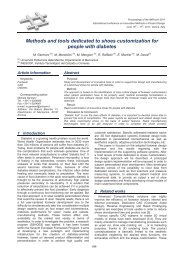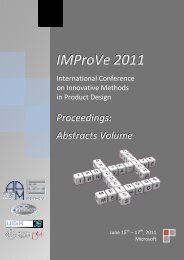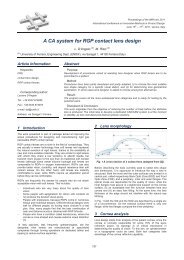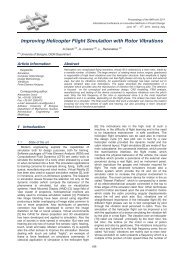IMProVe 2011 - Proceedings
IMProVe 2011 - Proceedings
IMProVe 2011 - Proceedings
Create successful ePaper yourself
Turn your PDF publications into a flip-book with our unique Google optimized e-Paper software.
Design Methods and Applications<br />
Carlo algorithms are simple to implement within a software code with respect to the<br />
Genetic Algorithms which are quite difficult to code.<br />
Keywords: Rapid Prototyping, Particle Swarm Algorithm, Unmanned Aerial Vehicle,<br />
Conceptual Design, Optimization.<br />
Corresponding Author: Alessandro Ceruti<br />
Tel.: 051/2093452 – 0543/374448<br />
Fax.: 0543/374477<br />
e-mail: alessandro.ceruti@unibo.it<br />
Address: University of Bologna - DIEM Department, V.le del Risorgimento 2, 40136 Bologna ; II<br />
Faculty of Engineering, Via Fontanelle 40, 47100 Forlì.<br />
Decision support system to design autonomous microsystems<br />
V. Dupé (a, b), R. Briand (a), X. Fischer (a, b), P. Sébastian (b)<br />
(a) ESTIA<br />
(b) I2M UMR CNRS 5295<br />
Abstract:<br />
Purpose:<br />
This article deals with modelling and design of embedded autonomous microsystems able<br />
to harvest energy from their close environment. Due to their numerous functionalities,<br />
progress in electronics and the development of wireless applications, microsystems are<br />
used in a wide range of applications. Moreover, they require a large autonomy to ensure<br />
reliability and avoid maintenance operations. We focus on energy harvesting to power<br />
them to replace the conventional energy source with an energy harvester. Different<br />
sources can be used but one difficulty is to select the most adapted to a specific<br />
application and choose the energy harvester architecture to get an efficient system.<br />
Method:<br />
A decision support to design autonomous microsystems working by harvesting energy is<br />
proposed. It aims to support designer’s decisions from qualitative representation to<br />
physical models. Our approach is based on the identification, analysis, modelling and<br />
minimization of antagonist flows and effects through a system-level model to estimate the<br />
energy that can be harvested.<br />
Result:<br />
The method is illustrated through a validation case dealing with the displacement and<br />
deformation measurement of a cantilever beam with an accelerometer. The aim is to<br />
choose the energy source and the architecture of the energy harvester to satisfy the<br />
requirements.<br />
Discussion & Conclusion:<br />
June 15 th – 17 th , <strong>2011</strong>, Venice, Italy<br />
109<br />
<strong>IMProVe</strong> <strong>2011</strong> - <strong>Proceedings</strong>










